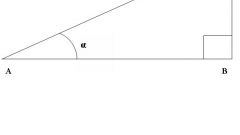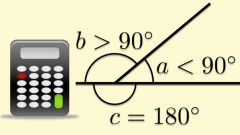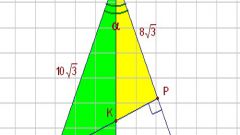Instruction
1
To find the cosine of an angle in a triangle, the lengths of the sides are known, we can use the theorem of the cosine ofs. According to this theorem, the squared length of an arbitrary side of a triangle equals the sum of the squares of its two other sides without twice the product of the lengths of these sides into the cosine of the angle between them:
and?=b?+c?-2*b*c*cos?, where:
a, b, C be the sidelengths of a triangle (or rather their lengths),
? – the angle opposite the side a (its value).
From these equalities easily is cos?:
cos?=( b?+c?-huh? )/(2*b*c)
Example 1.
There is a triangle with sides a, b, C equal 3, 4, 5 mm respectively.
Find the cosine of the angle between the long sides.
Solution:
According to the problem conditions we have:
a=3,
b=4,
C=5.
We denote the opposite side and the angle across the? then, according to the formula derived above, we have:
cos?=(b?+c?-huh? )/(2*b*c)=(4?+5?-3?)/(2*4*5)=(16+25-9)/40=32/40=0,8
The answer of 0.8.
and?=b?+c?-2*b*c*cos?, where:
a, b, C be the sidelengths of a triangle (or rather their lengths),
? – the angle opposite the side a (its value).
From these equalities easily is cos?:
cos?=( b?+c?-huh? )/(2*b*c)
Example 1.
There is a triangle with sides a, b, C equal 3, 4, 5 mm respectively.
Find the cosine of the angle between the long sides.
Solution:
According to the problem conditions we have:
a=3,
b=4,
C=5.
We denote the opposite side and the angle across the? then, according to the formula derived above, we have:
cos?=(b?+c?-huh? )/(2*b*c)=(4?+5?-3?)/(2*4*5)=(16+25-9)/40=32/40=0,8
The answer of 0.8.
2
If the triangle is rectangular, then to find the cosine ofa angle is enough to know only the lengths of any two sides of (the cosine of a right angle is equal to 0).
Suppose you have a rectangular triangle with sides a, b, C, where C is the hypotenuse.
Consider all the options:
Example 2.
Find cos?, if you know the lengths of the sides a and b (sides of triangle)
We use advanced Pythagorean theorem:
c?=b?+huh?,
C=v(b?+huh?)
cos?=(b?+c?-huh? )/(2*b*c)=(b?+b?+huh?-huh?)/(2*b*v(b?+a?))=(2*b?)/(2*b*v(b?+a?))=b/v(b?+huh?)
To check the correctness of the formula, substitute in the values from example 1, i.e.
a=3,
b=4.
Doing elementary calculations, we get:
cos?=0,8.
Suppose you have a rectangular triangle with sides a, b, C, where C is the hypotenuse.
Consider all the options:
Example 2.
Find cos?, if you know the lengths of the sides a and b (sides of triangle)
We use advanced Pythagorean theorem:
c?=b?+huh?,
C=v(b?+huh?)
cos?=(b?+c?-huh? )/(2*b*c)=(b?+b?+huh?-huh?)/(2*b*v(b?+a?))=(2*b?)/(2*b*v(b?+a?))=b/v(b?+huh?)
To check the correctness of the formula, substitute in the values from example 1, i.e.
a=3,
b=4.
Doing elementary calculations, we get:
cos?=0,8.
3
Similarly, is the cosine of the rectangular triangle in other cases:
Example 3.
Known a and C (hypotenuse and opposite side), find cos?
b?=with?-huh?,
b=v(c?-huh?)
cos?=(b?+c?-huh? )/(2*b*c)=(C?-a?+with?-huh?)/(2*s*v (? -a?))=(2*s?-2*a?)/(2*s*v (? -a?))=v (? -huh?)/C.
Substituting the values a=3 and C=5 from the first example, we get:
cos?=0,8.
Example 3.
Known a and C (hypotenuse and opposite side), find cos?
b?=with?-huh?,
b=v(c?-huh?)
cos?=(b?+c?-huh? )/(2*b*c)=(C?-a?+with?-huh?)/(2*s*v (? -a?))=(2*s?-2*a?)/(2*s*v (? -a?))=v (? -huh?)/C.
Substituting the values a=3 and C=5 from the first example, we get:
cos?=0,8.
4
Example 4.
Famous b and C (the hypotenuse and adjacent side).
Find cos?
Producing the same (shown in examples 2 and 3 of the transition), we obtain that in this case the cosine in the triangle is calculated by a simple formula:
cos?=b/C.
The simplicity of obtained formula is explained simple: in fact, adjacent to the corner ? side is the projection of the hypotenuse, so its length is equal to the length of the hypotenuse multiplied by cos?.
Substituting the values b=4 and C=5 from the first example, will get:
cos?=0,8
So all our formulas are correct.
Famous b and C (the hypotenuse and adjacent side).
Find cos?
Producing the same (shown in examples 2 and 3 of the transition), we obtain that in this case the cosine in the triangle is calculated by a simple formula:
cos?=b/C.
The simplicity of obtained formula is explained simple: in fact, adjacent to the corner ? side is the projection of the hypotenuse, so its length is equal to the length of the hypotenuse multiplied by cos?.
Substituting the values b=4 and C=5 from the first example, will get:
cos?=0,8
So all our formulas are correct.












